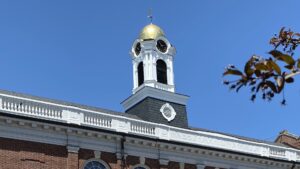
Looking Back at August 8th
August 10, 2023
• Director of Needham Public Works, Carys Lustig, explains the reasons behind the severe flooding and describes the DPW’s response to weather events.
On Friday, Needham declared a State of Emergency in connection with the storm that passed through on August 8th, flooding parts of the town. The goal was to facilitate any available State or Federal resources to help in the recover, repair or replacement of damaged property.
At Tuesday night’s Select Board meeting, the Board will hear a full review of the town’s recovery efforts after the storm from both the Town Manager and the Director of Public Works to date. On August 10th, news producer Ashley Julier had a conversation with DPW Director Carys Lustig in the immediate aftermath.
Q: Where were the major areas of flooding in town?
Carys Lustig, Director, Needham DPW: Around Junction at Chestnut, the Downtown had some flooding, and then I can say Great Plain Ave around Sportsman’s Pond, Alder Brook and the Reservoir, Rosemary Pond, they all had flooding involved, as well as Rosemary Brook. So, basically any water body that we had that was open water, we had flooding as a part of that.
Effectively, when there’s so much rain at one time and the water body can’t handle it, the water finds a way to go. So, it goes over the road when it can’t go through our systems.
Q: What led to all of this flooding?
Carys Lustig: Yeah, so it had a very small localized, intense event where it dropped a lot of rain in a very short period of time, and it also had to do with the fact that we had a very wet summer, particularly a very wet July.
So our system already had some capacity taken from that earlier weather. That weather’s been spread out, so it hasn’t created any surge or it hasn’t overwhelmed our system, but the amount of water that we received simply overwhelmed the system.
In some cases, it’s just simply so much water fell that the system wasn’t large enough for the
points to come in, and the intensity of the rain was just so significant that we had it flooding our manholes. And then also overwhelming all of our brooks and culverts.
Our system actually performed very well. Our roads are actually meant to be part of our drainage system. So when we get large rain events like that, the road is actually supposed to hold water until it can flow into our storm drain system. Within 45 minutes to an hour, I would say almost all roads in town were clear. So that actually shows a very strong system that we have.
It’s not an instantaneous effect, and so I think for people it’s concerning when it takes a little bit longer when the event’s over and the water’s still flowing, or even during an event when you see that water, that it feels like things aren’t working, but that’s actually how they’re supposed to work.
Q: Did the flooding cause any damage, whether it is public or private property or even to the environment?
Carys Lustig: So, on the public side, we had two town buildings that flooded during the event. We had the High Rock School, (where) water backed up through the parking lot and ended up causing flooding in that school, which we’ve since remediated, and the DPW Building was also flooded, and we have since remediated that as well.
We did have some flooding in people’s basements and garages as well as single level homes that are on a slab. We also had two sewer system overflows, so that’s when the sewage actually gets out into potentially our drainage system. That had to do with the amount of water that was pouring into our manholes, that was then overwhelming both the town systems and private systems. And so we were working, that was our first priority when we were dealing with the event, was to make sure that those items were under control and that our pumping stations could continue handling the high flow levels that were coming in, that we didn’t have any more of those sewer system overflows.
So that’s like more the environmental impact and there’s a lot of dilution there. So, you know, hopefully one would think more broadly it’s not a large environmental impact.
What we saw after the fact was a lot of debris around town, so we’ve been doing street sweeping in order to clear up the streets. There was also vehicles that did try to go through the water when it was high and some of those required rescuing. I also believe there was some equipment in parking lots that had flooding and some of that equipment was damaged as well.
Q: Is there anything else you think Needham residents should know?
Carys Lustig: One of the things that might be useful to know when we have weather events is how we triage our work through an event like that. So, it’s the same thing with any type of emergency, but our first priority is protecting the town wide infrastructure. So, in this particular case it was monitoring the roads, the sewers, and any flooding that we had, the storm drain issues. That’s really where we focused during that emergency to begin with.
Then we will go out once those systems are made safe, and address individual homeowner’s concerns on a safety basis first. So, that’s when we’ll address, particularly in this case,
sewage was the number one item that we were addressing in the post time. And then afterward if there’s issues or like a resident can’t pump down their basement or they have an issue getting a contractor out, then we might go help them. And then afterwards, we’re kind of hitting that last phase. That’s when we start talking about like systems and and issues.
If people have water in their backyards, that’s really the lowest priority item for us because it’s not endangering safety and wellbeing. It’s very different for us than somebody having water in their their house or, even worse, sewage in their house. So those are the priorities that we have.
I recommend that for system-wide issues, if you saw an area that was flooded in town, I recommend throwing it in our town’s website on our Report An Issue. Just indicate, “Hey, this was an area where we saw a lot of flooding, it tipped over the road.” Those are items that we can then look at after the fact, when we’re trying to build out our capital plans and say, “You know, across the town, where are there issues where we could potentially improve storm water retention?” and figure out if there’s solutions that can be done.


